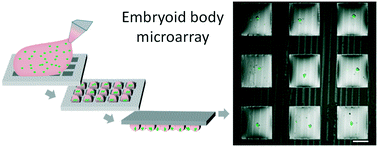Our official English website, www.x-mol.net, welcomes your
feedback! (Note: you will need to create a separate account there.)
Droplet microarray: miniaturized platform for rapid formation and high-throughput screening of embryoid bodies†
Lab on a Chip ( IF 6.1 ) Pub Date : 2018-07-02 00:00:00 , DOI: 10.1039/c8lc00450a Tina Tronser 1, 2, 3, 4 , Konstantin Demir 1, 2, 3, 4 , Markus Reischl 1, 3, 4, 5 , Martin Bastmeyer 1, 1, 4, 6, 7 , Pavel A. Levkin 1, 1, 2, 3, 4
Lab on a Chip ( IF 6.1 ) Pub Date : 2018-07-02 00:00:00 , DOI: 10.1039/c8lc00450a Tina Tronser 1, 2, 3, 4 , Konstantin Demir 1, 2, 3, 4 , Markus Reischl 1, 3, 4, 5 , Martin Bastmeyer 1, 1, 4, 6, 7 , Pavel A. Levkin 1, 1, 2, 3, 4
Affiliation

|
Stem cells are influenced by various factors present in their in vivo microenvironment, such as interactions with neighboring cells, the extracellular matrix or soluble molecules. This demonstrates the high complexity of the in vivo microenvironment. Hence, many advances have been made in developing 3D screening models mimicking this complexity and the in vivo-like state in order to ensure more biomedically relevant investigations in drug discovery. In the field of stem cell research embryoid bodies are often used as relevant 3D systems. Embryoid bodies are embryonic stem cell aggregates that recapitulate the early embryonic development and that can differentiate into derivatives of the three germ layers. Embryoid bodies enable the investigation of processes underlying embryonic development, tissue generation and identification of drugs with developmental toxicity. The ability to perform high-throughput screenings using embryoid bodies could be extremely important to accelerate the progress in the field of stem cell research and embryonic development. To date, there are no simple methods to create high-density microarrays of embryoid bodies that further enable their high-throughput screening important for biomedical research. Here we demonstrate a new method that enables formation and high-throughput screening of embryoid bodies in arrays of defined, separated microdroplets. Using the superhydrophobic–hydrophilic micropattern of the droplet microarray, we demonstrate rapid and facile one-step formation of a dense array of multiple droplets containing homogeneous, single embryoid bodies. Thorough characterization of the influence of the initial cell number on embryoid body size, roundness and distribution was performed. We applied the embryoid body microarray to screen 774 FDA-approved compounds, identifying compounds with developmental toxicity such as mycophenolate mofetil or embryonic lethality such as eptifibatide. This work demonstrates the potential of the droplet microarray for the rapid formation of high-density microarrays of single embryoid bodies and their high-throughput drug screenings.
中文翻译:

液滴微阵列:用于快速形成和高通量筛选拟胚体的微型平台†
干细胞受其体内微环境中各种因素的影响,例如与邻近细胞,细胞外基质或可溶性分子的相互作用。这证明了体内微环境的高度复杂性。因此,在开发模仿这种复杂性和体内效果的3D筛选模型方面已取得了许多进展。类状态,以确保在药物发现中进行更多与生物医学相关的研究。在干细胞研究领域,拟胚体通常用作相关的3D系统。胚状体是胚胎干细胞聚集体,可以概括早期的胚胎发育,并且可以分化为三个胚层的衍生物。胚状体可以研究胚胎发育,组织生成和鉴定具有发育毒性的药物的过程。使用类胚体进行高通量筛选的能力对于加快干细胞研究和胚胎发育领域的进展可能极为重要。迄今为止,没有简单的方法可以创建高密度的拟胚体微阵列,以进一步进行高通量筛选,这对生物医学研究很重要。在这里,我们演示了一种新方法,该方法能够在定义的,分离的微滴阵列中形成拟胚体并进行高通量筛选。使用液滴微阵列的超疏水-亲水微模式,我们证明了快速且简便的一步形成一个密集阵列的多个液滴,这些液滴包含均质的单个胚状体。完整表征了初始细胞数目对胚状体大小,圆度和分布的影响。我们将类胚体微阵列用于筛选774种FDA批准的化合物,鉴定具有发育毒性的化合物(例如霉酚酸酯)或具有胚胎致死性的化合物(例如埃替非巴肽)。这项工作证明了液滴微阵列可快速形成单个胚状体的高密度微阵列及其高通量药物筛选的潜力。
更新日期:2018-07-02
中文翻译:

液滴微阵列:用于快速形成和高通量筛选拟胚体的微型平台†
干细胞受其体内微环境中各种因素的影响,例如与邻近细胞,细胞外基质或可溶性分子的相互作用。这证明了体内微环境的高度复杂性。因此,在开发模仿这种复杂性和体内效果的3D筛选模型方面已取得了许多进展。类状态,以确保在药物发现中进行更多与生物医学相关的研究。在干细胞研究领域,拟胚体通常用作相关的3D系统。胚状体是胚胎干细胞聚集体,可以概括早期的胚胎发育,并且可以分化为三个胚层的衍生物。胚状体可以研究胚胎发育,组织生成和鉴定具有发育毒性的药物的过程。使用类胚体进行高通量筛选的能力对于加快干细胞研究和胚胎发育领域的进展可能极为重要。迄今为止,没有简单的方法可以创建高密度的拟胚体微阵列,以进一步进行高通量筛选,这对生物医学研究很重要。在这里,我们演示了一种新方法,该方法能够在定义的,分离的微滴阵列中形成拟胚体并进行高通量筛选。使用液滴微阵列的超疏水-亲水微模式,我们证明了快速且简便的一步形成一个密集阵列的多个液滴,这些液滴包含均质的单个胚状体。完整表征了初始细胞数目对胚状体大小,圆度和分布的影响。我们将类胚体微阵列用于筛选774种FDA批准的化合物,鉴定具有发育毒性的化合物(例如霉酚酸酯)或具有胚胎致死性的化合物(例如埃替非巴肽)。这项工作证明了液滴微阵列可快速形成单个胚状体的高密度微阵列及其高通量药物筛选的潜力。











































 京公网安备 11010802027423号
京公网安备 11010802027423号